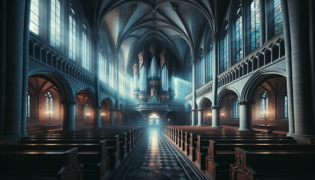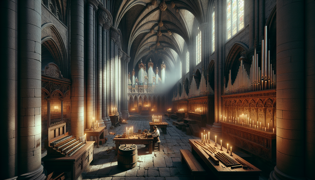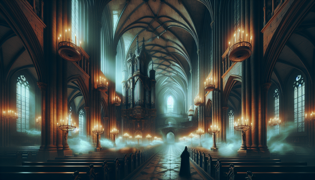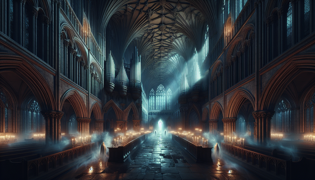The Phantom Organ of Lucerne
Reading Time: 13 min

About Story: The Phantom Organ of Lucerne is a Legend Stories from switzerland set in the Medieval Stories. This Dramatic Stories tale explores themes of Good vs. Evil Stories and is suitable for All Ages Stories. It offers Cultural Stories insights. An eerie midnight summons across Hofkirche’s ancient aisles.
Introduction
High above the cobbled lanes of Lucerne, the twin spires of the Hofkirche stood like watchful titans carved in granite, their silhouettes etched against a sky bruised by twilight. Within those ancient walls, legend held that at the stroke of midnight an unseen hand coaxed the organ’s ivory keys into motion, unleashing spectral chords that lingered like frost on the soul. The musty scent of ancient wood and rosin seeped from every pipe, stirring memories long entombed in mortared stone. Villagers hushed their footsteps outside the church, drawn by a melody that defied mortal craftsmanship, pinpointing the heart of mystery and den Nagel auf den Kopf treffen in a single trembling note. Scholars whispered of pacts sealed in candlelight, while elders warned that Da liegt der Hund begraben when a tune dripped from darkness. A distant wind sighed through narrow alleys, carrying the echo of a funeral march that caressed the ear like a ghostly lullaby. Even seasoned watchmen quivered at the organ’s prelude, for the music carried more than sound—it bore the weight of vanished lives seeking passage. In this realm between earth and ether, a phantom choir awaited its conductor on a stage of moonlit frescoes, each fresco a frozen promise of apparitions to come. The organ was heir to centuries of secrets, and every midnight performance reknit the fragile veil separating the living from the dead. Windows dripped with condensation like mourning tears, and the cool stone floor felt slick beneath trembling feet. A faint odor of melting tallow clung to the air as if pleading to be remembered. The organ’s pipes curved like coiled serpents, waiting patiently for the midnight call. Once, an apprentice swore he saw candlelight dancing along the balconies, though no wick had been struck. Lucerne’s nights held their breath, caught in a web of expectant silence and reverent fear.
Origins of the Midnight Melody
Long before Lucerne sprawled across the Reuss and steamers glided past wooden bridges, the Hofkirche’s foundations were laid upon ancient bedrock quarried from local cliffs. Master organ builder Johann Steiger, a man as devout as he was obstinate, toiled for eight winters and summers to assemble an instrument whose pipes were rumored to contain slivers of Alpine yew, each harvested under a blood moon. The workshop smelled of fresh timber and molten lead, a pungent aroma that clung to the weaver’s bench and the craftsman’s hands, intertwining aspiration and obsession. He carved bellows from supple leather and polished every key until it gleamed like an archer’s arrowhead, aiming to pierce the heart of worship. Locals spoke in hushed tones of tool chimes harmonising in the twilight forge, a clandestine overture hinting at power beyond mortal ken. At the unveiling ceremony, candles flickered as though startled, their flames dancing upon mosaic floors like startled birds. Parishioners wept tears of joy, though none could foresee the music that would one day breathe with ghostly autonomy. Under the amber glow of lanterns, the walls themselves seemed to breathe, oozing moisture that cooled the skin like a ghostly caress. Each pipe end was inscribed with runic flourishes, as if Steiger prayed to unseen patrons for guidance. When the organ was finally unveiled, its first chord reverberated so profoundly that the earth beneath the church quivered for an instant, startling even the aging gargoyles perched outside.

As the organ aged, its timbre deepened, resonant as mountain thunder rolling across granite peaks. Town records from 1523 recount an incident so strange it hardened the marrow of skeptics. During a torrential downpour, Steiger's apprentice, Elsbeth, ascended the pulpit to examine a stubborn pneumatic valve. She reported a solitary key depressed itself, unleashing a low drone that wound around her ankles like a living chain. In alarm she retreated, yet the drone pursued, echoing through ribbed vaults until struck dumb by its own uncanny presence. Investigators found no wiring, no phantom player—only the instrument, still warm to the touch, humming as cold as alpine snow at dawn. Some said the organ had “woken,” inheriting a fragment of its maker’s soul, a sentiment so haunting it seemed to pierce the veil between life and death with every note.
By the late 16th century, rumor had magnetised curiosity-seekers from across Europe. Aristocrats and clergymen alike sought audience in candlelit midnight vigils, hoping to witness the organ’s strange autonomy. They drew fortunes in fees and offerings, shoveling silver coins into alms boxes as though buying entry to a carnival of phantoms. At times, scholars inscribed notes by flickering torchlight, mapping the ghostly chords as if charting constellations. But the sequences defied all theory; scales twisted like serpentine vines and chords blossomed into spectral showers of sound. The church’s stone walls, engraved with saints and martyred angels, seemed to lean forward as though eager to inhale each bar. When the organ fell silent at dawn, the gloom returned so swiftly that memory itself felt robbed of sensation.
Yet despite growing dread, the organ remained a symbol of Lucerne’s spiritual might, its legend whispering through oak-panelled taverns like the scent of aged schnapps lingering in cracked glasses. Some elders claimed that each note summoned a soul bound for judgment, while others insisted it simply echoed grief stored within the walls. Scholars who dared to transcribe its music were driven to fevered journals and cryptic notations, their handwriting slanted like gnarled cedar roots pursuing hidden streams. In local tongues they muttered “Da liegt der Hund begraben,” sensing the true heart of the mystery lay buried beneath layers of time and faith. Thus the organ’s origins merged craftsmanship with myth, forging an everlasting tale that would later entwine with the lives of watchmen and wanderers, all drawn into its nocturnal embrace.
Over generations, the organ’s story seeped into lullabies and local ballads sung in smoky inns where hearth fires flickered like attentive listeners. Midwives hummed adapted motifs to lull infants, oblivious to the depth of sorrow entwined in each refrain. A leather-bound book, discovered beneath a collapsed choir bench in 1689, contained cryptic diagrams suggesting clandestine rituals – circles drawn in charcoal, with symbols echoing the shape of organ pipes. Some speculated that early diviners had consecrated the instrument with incantations whispered in Latin to harness the boundary between life and death. Even the tenderest creaking of pews seemed composed, as though the church itself awaited the organ’s summons like a devoted acolyte.
The Chronicles of the Watchmen
In the murk of pre-dawn hours, the church’s heavy doors groaned open to admit the night watchman Franz Müller, a tall, lean figure whose cloak bore the faint aroma of pine resin. His task was simple in theory: guard the empty nave until the first light of dawn. Yet each step rang like a hammer strike on polished stone, sending ripples of sound that merged with the building’s timeless quiet. He wore stout boots, their soles worn thin by endless patrols, and carried a lantern whose flickering glow danced over carved pews like restless spirits. On his first shift, Franz mapped the church’s every shadow, tracing arches with his gaze as though measuring the weight of centuries. He noted the echo of distant bells wavering against stone, a low toll that could have been wind or an unseen congregation at prayer. That night, the air tasted of cold incense and damp moss seeping through fallen stones, a sensory tapestry that clung to memory like cedar resin.

Within a fortnight, Franz learned to anticipate the organ’s stirrings. At precisely 23:57, as if wind-up by a phantom clock, the pedalboard exhaled a breath of solitary bass that rolled across the floor like a river of smoke. The sound was softer than a summer breeze weaving through mountain pines yet more insistent than a war drum’s throb. Franz pressed himself against a column, fingertips grazing cold stone, and listened as the melody blossomed layer by layer. He scribbled notes in a ragged journal by lantern light, hoping to capture the pattern of intervals and pauses. Under the vaulted ceiling, each chord soared like eagles taking wing, then spiraled downward in plummeting arcs reminiscent of shooting stars. Even the organ bench creaked in time, as though animated by its own fleeting desire to play.
As weeks passed, Franz’s sleep became haunted by the organ’s motifs, drifting into restless dreams where pipes twisted into serpentine forms and ghostly fingers hovered over ivory keys. He found himself humming passages at odd moments, in the marketplace or amid bakeries where the scent of cinnamon rolls hinted at ordinary life. Yet the memory of the church’s damp cold clung to him like a shadow, reminding him that some melodies carried weight beyond mere notes. The watchman’s reputation for stoicism began to fray, and villagers whispered in hushed chatter that Franz was becoming a man tethered to midnight. Some remarked he had become fluent in stillness, mastering silence as though it were a second language. Others envied his courage, unaware that fear had already taken root in his veins.
One turbulent evening in autumn, a howling wind raked through broken windowpanes and extinguished Franz’s lantern, plunging him into abyssal black. The organ’s opening chord returned with unexpected ferocity, filling the darkness with living sustenance, as though the music sap flowed through the church’s veins. In that void of light, Franz felt the hair on his neck rise, as if spectral spectators pressed close. Then, in a sudden hush, the keys stilled, leaving only the pitter-patter of rain on the roof. When he relit his lantern, he discovered a single white rose laid upon the organ bench, its petals moist and fragrant. Franz knew then that the watcher had become watched, and that the organ’s unseen audience extended beyond mortal thresholds.
His journal entry for that night was a blur of trembling script and half-formed sketches, diagrams of swirling notes that defied classical notation. He dashed lines across margins, flanked by spilled wax droplets that glimmered under torchlight like tiny constellations. Franz resolved to share his findings with the city’s magistrate, yet fear knitted his lips shut; who would believe a man who conversed in music with ghosts? Instead he returned again and again, driven by a mix of dread and fascination. The church, with its frost-tipped arches and silent choirs carved in stone, had become both sanctum and trap, shaping his destiny with every midnight cadence.
The Night of the Unseen Choir
All Saints’ Eve in Lucerne carried a hush thicker than any fog known to wander the Alpine foothills. Lanterns bobbed like distant fireflies in the cobbled streets as locals drifted toward the Hofkirche, carrying small bouquets of yarrow and marigold. The air held the tang of wet stone and the sweet decay of fallen petals, an unlikely perfume that accompanied their solemn procession. Inside, the church stood pearl-white in lantern glow, its walls alive with frescoes depicting saints locked in eternal contemplation. The benches had been cleared of cobwebs, and each pew was draped in black velvet, absorbing light like raven feathers. Here, at the crossroads between the living and the dead, the organ awaited its moment.

A hush grew pregnant with anticipation until the first bell of eleven tolled, its note reverberating like a ripple across a still pond. The congregation bowed, lips moving in silent prayer, while up in the loft the organ pipes breathed in unison. At 11:59, a single key descended without warning, releasing a chord so clear it felt as if the sky itself had opened. And then the floodgates swept open. The music cascaded through the nave like molten silver, swirling around pillars and wrapping itself around quivering ribs. Lights danced in the walls’ relief carvings, transforming stone angels into flickering phantoms caught in an otherworldly ballet. Some listeners clasped trembling hands; others closed their eyes, surrendering to a melody older than any memory.
As the notes soared, a host of pale figures emerged from niches and alcoves, stepping with slow deliberation into the lunar glow. They wore garments the color of stale parchment and moved with a dignity that banished any notion of fear. Their mouths opened in silent song, the faint texture of their voices forming an invisible counterpoint to the organ’s chords. Franz, perched on a narrow balcony, watched with awe as souls once bound by mortal coils drifted free, their contours shimmering like morning mist. He smelled the faintest trace of lavender, as if the departed carried tokens of earthbound life into eternity. The wrestle between shadow and substance played out under Gothic arches, each lamentation weaving a fragile thread between past and present.
The music climaxed in a crescendo that shook the stained glass, causing fractured beams of colored light to dance across the stone floor like shards of a broken rainbow. Mirrors of serpentine pipes quivered in vibration, each tone stirring echoes from crypts below. For an instant, Franz felt unmoored, hovering between heaven’s breath and the earth’s heartbeat. Then the final chord rang out, resonating so slowly that silence itself seemed to sigh in relief. The phantoms receded into darkness, following invisible conduits back to places beyond mortal reckoning. In their wake, the organ stood solemn, resting its soul until the next call.
When dawn’s pale fingers brushed the sky, the congregation dispersed in stunned reverence, footprints on vitrified stone marking their passage. Franz descended the narrow stairs to the nave, where the single white rose lay atop the organ bench, its petals now wilted yet still crowned with dew. He cradled it gently, as though grateful for a final benediction from those unseen choristers. Word of that night rippled through Lucerne, weaving into letters, diaries and whispered conversations in taverns. The organ’s midnight vigil had become a covenant between realms, sealing Lucerne’s place as a city where the veil grows thin when ancient pipes awaken.
Conclusion
In the centuries that followed, the Phantom Organ of Lucerne evolved from whispered legend to emblem of the city’s enduring bond with the unseen. Pilgrims still gather on All Saints’ Eve, hearts brimming with wonder and just a trace of dread, each drawn by rumors of spectral harmonies rising from the Hofkirche’s pipes. The organ itself endures under careful stewardship, its weathered keys and pipes maintained with reverence bordering on worship. Visitors report tingles along their spines as they pass beneath the archways at midnight, half-expecting chords to shimmer into the air at any moment. While skeptics dismiss the phenomenon as trickery of wind or tarnished mechanisms, those who have witnessed the phantom choir carry a conviction that defies explanation. Today, the legend remains a vital thread in Lucerne’s tapestry, a reminder that music can bridge worlds and stir the most dormant echoes of the heart. Whether driven by faith, fear, or longing, people ascend the church’s steps time and again to stand beneath its vaulted ceiling, listening for that first solitary note. In the hush that follows, they become part of a tradition woven through generations—a vigil that calls us to wonder what lies just beyond our hearing.

















